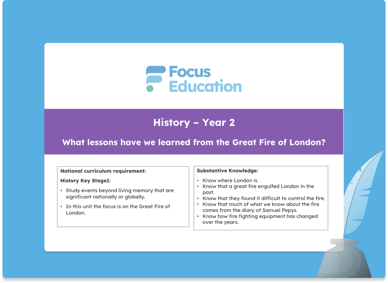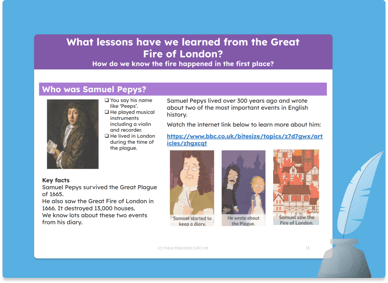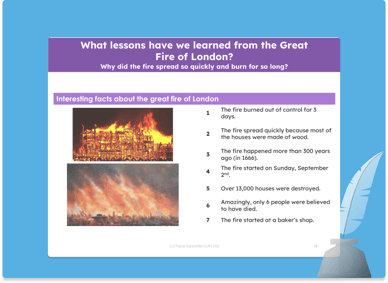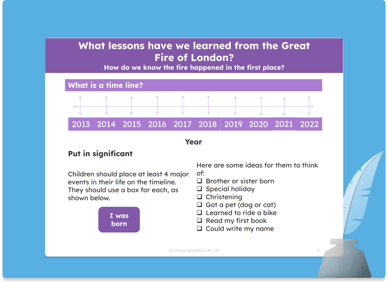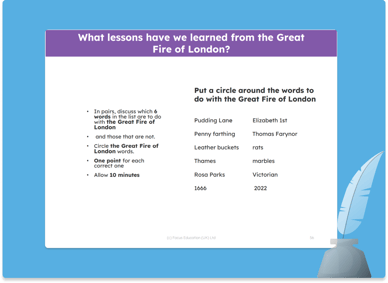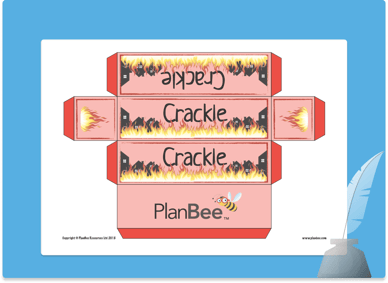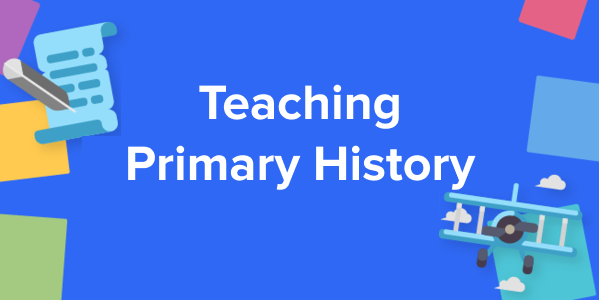Teaching the Great Fire of London: Activities & Resources for KS1
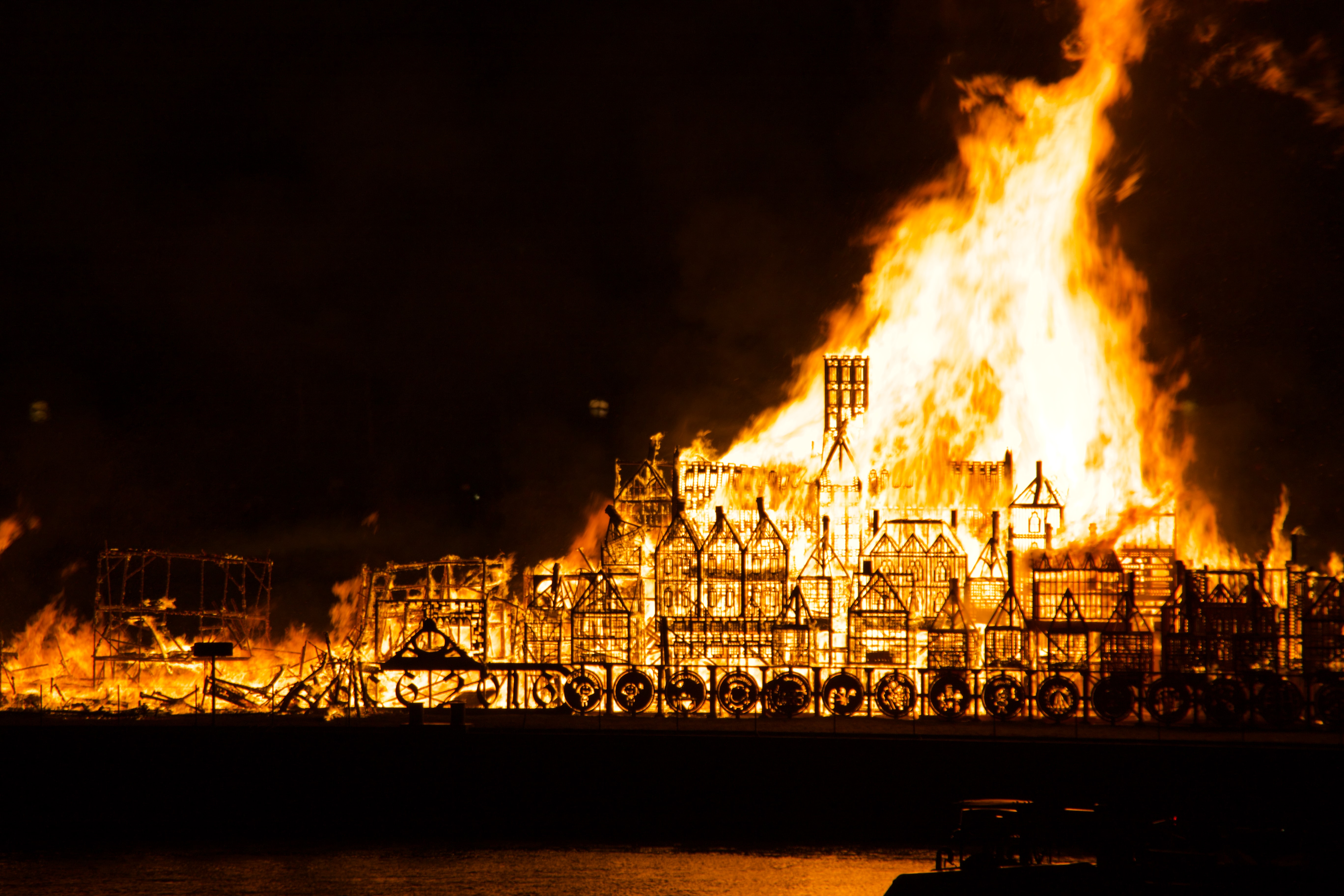
The Great Fire of London has been a staple in the KS1 history curriculum for decades. Why? Because it’s an exciting and dynamic story that captures the attention of young children and impacted London, and the country, in a way that can be seen today.
The KS1 history curriculum is all about giving pupils the opportunity and skills to learn about significant events that shaped our history, and the people that were there and shaped those events in our eyes. The Great Fire offers both, transporting pupils back to a time very different from their own.
What was The Great Fire of London and how did it happen?
The Great Fire of London was a fire that spread across London over 5 days in 1666, destroying some 13,000 homes and leaving more than 100,000 people homeless. Only 6 people are believed to have died in the fire, though records were not well kept in those days.
The fire started on Sunday the 2nd of September when Thomas Farriner, a baker to the King, failed to properly put out his oven and a spark lit the bakery alight while he slept.
Then, as now, the homes in London were built extremely close together, so the fire spread easily. Unlike today, the houses were made from wood and straw, so there was nothing to slow or contain the fire, especially due to the strong winds that encouraged the fire over the first 4 days. To make the situation worse, there were no taps or water pressure, so all the water used to put out the fire had to be carried from the river and wells.
After the fire burned down St. Paul’s Cathedral, the army decided to use gunpowder to blow up the houses closest to the Tower of London to protect it and stop the fire from spreading further. Finally, with nothing more to burn, the fire burned out.
We got most of our information about the Great Fire from a man called Samuel Pepys, who kept a diary throughout the fire, recording the events of those fraught 5 days.
After the fire, London had to be rebuilt, this time using brick and stone. Fire brigades were formed for the first time since the effort to put out the fire had been so disorganised. St. Paul’s Cathedral was rebuilt, designed by Sir Christopher Wren, but the project took almost 40 years to complete. The one big positive from the fire is that the remaining traces of the Plague were wiped out, as many infested homes and possessions were burned, eradicating the last of the virus.
Activities & Resources for Teaching The Great Fire of London
This Year 2 unit created by Focus Education will guide your students through how and why the fire started, adopting an enquiry-based approach to engage pupils whilst developing key ks1 history skills. It also discusses how the fire shaped the London we know today, helping pupils link events of the past to the present day and their own lives. The unit is packed full of lessons, presentations, plans, games and activities so you have everything you need to teach Year 2 about the Great Fire of London!
You can explore the Great Fire of London History Unit for free by starting a commitment-free trial!
Samuel Pepys, the diary writer who gave us so much information about the Great Fire (and the Plague), is a central figure in the Great Fire story. This fact file is a part of the unit above and contains essential information about Pepys. It's perfect for quickly introducing your class to Samuel Pepys and contains some great facts that you can later test your pupils on!
This fact file contains 7 key facts about Great Fire. It's perfect as an individual resource for an engaging introduction to the Great Fire, but it can also be used as part of a year 2 history lesson that asks, “why did the fire spread so quickly and take so long to put out?”.
This timeline is a great resource for not only teaching year 2 pupils about the chronology of the Great Fire of London, but also for introducing young pupils to the concept of timelines. The resource encourages pupils to take an enquiry-based approach to their learning, thinking about how to put the events that lead to the start of and the conclusion of the fire in order. This year 2 history resource also teaches about chronology by getting pupils to reflect on their own timelines, giving them the opportunity to create a timeline of their lives.
Word Sorts is a 10-minute group activity where children are asked to examine a list of 12 words and numbers and decide which 6 relate to the story of the Great Fire of London. This activity encourages children to work together and discuss the events and their ideas to decide which words are relevant and why. It's a great resource for encouraging collaboration and inquisition, ensuring learners are progressing with the key skills outlined in the national history curriculum
A fun activity for children to start the Great Fire topic with, these name labels can be coloured in and placed on their desks while covering this topic. It's a really quick and easy way of bringing the topic to life in your classroom.
The Museum of London offers an interactive version of the story that’s well-produced and gives children an opportunity to see what it was like to live through the events of the Fire. Pupils can help two characters as they move through the story. This is a great resource that can be used individually, in groups, or as a class, depending on what resources you have.
If you have access to Minecraft on your school computers, you can download this map and pupils can play through the events of the fire for themselves on Minecraft. They can find hidden objects, fight the fire, and work to rebuild the city. They offer extensive instructions for installation, so don’t panic if the idea of installing the custom map is daunting.
Teaching KS1 history can be daunting, but with the right activities and resources, it need not be. If you’re new to teaching KS1 history, make sure you read our overview of how to teach the KS1 curriculum. If you feel like your history lessons are a little dry, our top tips on how to make your history lessons more engaging will help you build excitement for learning about history.
To explore all the Great Fire of London teaching resources we have on Pango, for free, start a commitment-free trial today!

